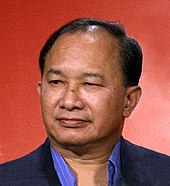Eastern
The term Eastern [ iːstərn ] (of tight. : Eastern , east '; rhetorical analogy to the film genre of the Western : western , west') describes a genre of commercial entertainment cinema , where the stylistic features of American genre cinema are processed in Asian films. Style-defining are elements of the American western. To some extent, Eastern synonymously of the genre of martial arts film used with which it is closely related and, in turn, in the genres Wuxia and jidaigeki can be divided. The term also refers to classic Hollywood films with oriental locations, especially in the United States .
Characteristics
In Germany, the term is often used as a generic term for certain styles of Chinese and Hong Kong cinema , such as action and martial arts films , especially from the 1960s. In these films, elements of Japanese samurai films , but also dramaturgies , plot structures and character concepts from American genre films are taken up and combined with the aesthetics of Far Eastern martial arts . Important representatives of the Eastern are directors such as Chang Cheh ( New One Armed Swordsman , 1967; The Duel , 1971), Sammo Hung ( Operation Eastern Condors , 1986), Ching Siu-Tung ( A Chinese Ghost Story , 1987), Tsui Hark ( Once Upon a Time in China , 1991), Wong Jing ( The Last Blood , 1990) and John Woo as well as the actors Jackie Chan , Jet Li , Bruce Lee , Chow Yun Fat and Michelle Yeoh .
Since the 1980s, the influence of the Eastern can again be demonstrated in American cinema , which is reflected in the aesthetics of films such as Matrix (1999) or Kill Bill (2003). Films such as The Magnificent Seven (1960; template: The Seven Samurai , 1954) and For a Handful of Dollars (1964; template: Yojimbo , 1961) can be traced back to films of the Eastern genre. But it was not until the films by John Woo from the 1990s onwards ( Face / Off , 1997; Mission: Impossible II , 2000) that it became clear that the Eastern is finding strong influence in American entertainment cinema.
Films from early Hollywood cinema with oriental locations are sometimes referred to as Eastern , especially in the USA. Such films were adventure films in the broadest sense ( The Sheikh , 1921; Three Foreign Legionaries , 1939) with motifs from the Arabian Nights such as The Thief of Baghdad (1940), which enjoyed particular success in the 1940s and 1950s. Borrowings from the western genre can be demonstrated: The man from the desert who ensures justice in a city ( Ali Baba and the forty robbers , 1944; The desert falcon 1950), the revenge on the murder of a family member ( Das goldene Schwert , 1952 ) or taming a legendary wild horse ( The Flame of Arabia , 1951).
literature
- Jasper P. Morgan: The Eastern Movie . The bone breakers with the death claw. tape 1 . Mpw, 2003, ISBN 3-931608-56-5 .
- Leo Moser: Eastern Lexicon . Schwarzkopf & Schwarzkopf, 2001, ISBN 3-89602-286-5 .
- John C. Eisele: The Wild East . Deconstructing the Language of Genre in the Hollywood-Eastern. In: Cinema Journal 41 . 2002, p. 68-94 .
- Matthew Bernstein, Gaylyn Studlar: Visions of the East . Orientalism in film. Rutgers University Press, New Brunswick 1997.
Individual evidence
- ↑ a b Felicitas Kleiner : Eastern . In: Lexikon der Filmbegriffe, edited by Hans. J. Wulff and Theo Bender
- ^ Andreas Rauscher: Martial-Arts-Film / Eastern . In: Thomas Koebner (Hrsg.): Sachlexikon des Films . 2nd Edition. Reclam, 2006, ISBN 978-3-15-010625-9 , pp. 420-423 .
- ↑ a b Felicitas Kleiner: Hollywood-Eastern . In: Lexikon der Filmbegriffe, edited by Hans. J. Wulff and Theo Bender
- ↑ Björn Rosen: Something new in the western . In: Der Tagesspiegel . November 8, 2009.
